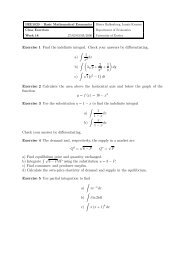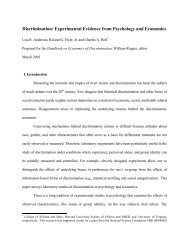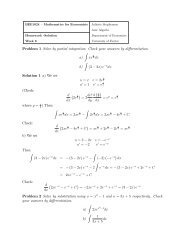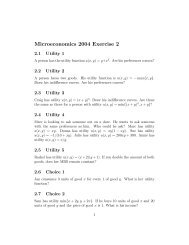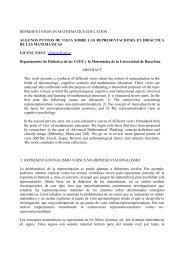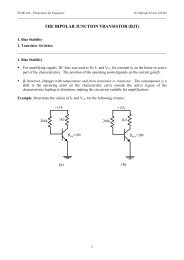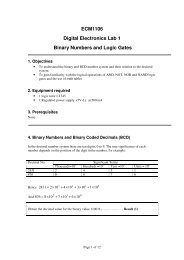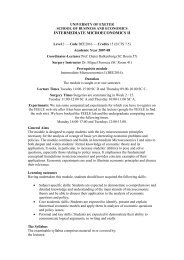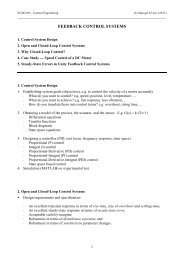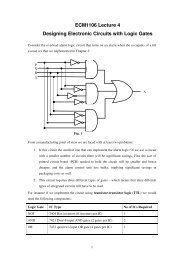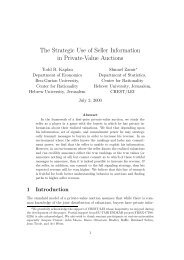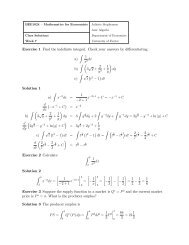Group Identity and Social Preferences
Group Identity and Social Preferences
Group Identity and Social Preferences
Create successful ePaper yourself
Turn your PDF publications into a flip-book with our unique Google optimized e-Paper software.
Support. In Table 2, column 5 presents t-statistics for one-tailed tests on the difference betweencolumns 3 <strong>and</strong> 4 for paired samples. The average allocation to an ingroup match is substantiallygreater than that to an outgroup match. The difference is statistically significant at the 1% level inall cases.By Result 1, we reject Hypothesis 1. In other words, with real incentives <strong>and</strong> groups based ontrue painting preferences, we replicate the ingroup favoritism result of minimal group paradigmexperiments.[Figure 2 about here.]Regarding the effect of group identity on social preferences, Figure 2 shows the fraction ofPlayer B’s choices which are consistent with self-interest, charity, envy, positive <strong>and</strong> negativereciprocity, <strong>and</strong> SWM. 15 Although the categories are not mutually exclusive, the comparison ofbehaviors across ingroups, outgroups <strong>and</strong> the control is informative. Figure 2 reveals that theparticipant choices depend on the match’s group affiliation. In particular, we observe that, withingroup matching, a smaller fraction of participants are self-interested, willing to choose an actionthat leads to a higher payoff for themselves, or willing to punish their matches for misbehavior,while a larger fraction of them are willing to tolerate their payoff being behind, to choose the SWMaction, or to reward their match for helping. The patterns suggest that, when interacting with aningroup member, individuals show less self-interest, greater charity concerns, less envy, greaterwillingness to maximize joint payoffs, higher likelihood of positive reciprocity, <strong>and</strong> more leniencytowards misbehaviors. When comparing the control sessions with the treatment sessions, we alsofind that the control results lie between those of the ingroup <strong>and</strong> outgroup matching pairs for eachcategory. We next use econometric methods to estimate the effects of group identity on participantsocial preferences.We first analyze the effect of group identity on distribution preference, i.e., charity <strong>and</strong> envy,without reciprocity. We use Player B’s data from the sequential games to estimate the parametersof Equation (4). Our maximum-likelihood estimation on our binary-response data uses a logitspecification:e γ·u(action1)Prob(action 1) =, (5)e γ·u(action1) + eγ·u(action2) where the parameter γ reflects the sensitivity of the choices to utility differences. When γ = 0,this model is reduced to a r<strong>and</strong>om choice model with equal probability. When γ is arbitrarily large,the probability of choosing the action with higher utility approaches one. In general, the higher thevalue of γ, the sharper the model predictions (McFadden 1981).[Table 3 about here.]Table 3 reports the results of our parameter estimation. As a benchmark, we estimate the charity<strong>and</strong> envy parameters for the control sessions. For the treatment sessions, we report the parameterestimates for both ingroup <strong>and</strong> outgroup matches as well as their differences, as represented byparameters a <strong>and</strong> b. We now summarize our main results based on the estimates.15 Games Dict 5, Resp 5a <strong>and</strong> 5b, <strong>and</strong> role B in game Resp 9 are excluded from the SWM model since all outcomesyield the same aggregate payoff. The fractions in the “Rewarding” <strong>and</strong> “Punishing” categories are computed basedon the positive- <strong>and</strong> negative-intentionality games, respectively. Computations for other categories are based on allgames.11



